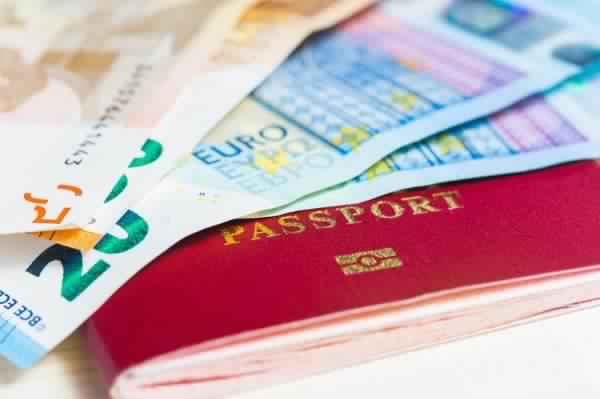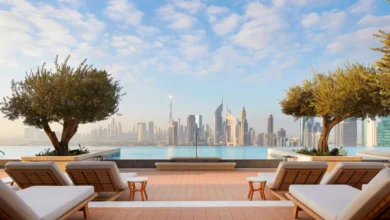
A portrait of a young Queen Elizabeth II gazes over all who pass through security at Bermuda’s LF Wade International Airport, a royal welcome for visitors to Britain’s oldest overseas territory in a room that wouldn’t look out of place in an English stately manor.
The airport’s runway sits seemingly inches above the waves on reclaimed land at the northeast point of the volcanic archipelago, providing a spectacular ocean landing that reminds you how earlier nautical travelers once reached these pristine shores.
Arriving on the Bermuda Islands or “Somers Isles” is an experience all of its own: passing through a time-warped gateway echoing colonial days past, built with cutting-edge engineering, into a giant clubhouse where some of the wealthiest people on the planet live and play.
It’s an easy choice, if you can afford it. The average cost of a house on any of the eight main islands is about a million dollars, and patches of coastline without an adjoining jetty cram-packed with luxury yachts are few, though there are still those unspoiled.
While closer to Canada than the Caribbean and just a 90-minute hop from New York’s JFK airport, Bermuda’s winter-busting climate is kept warm by the Gulf Stream. So, while the US East Coast was being lashed by superstorm Sandy, New Yorkers with money to burn were golfing or paddling about in a pool here, taking care to avoid sunstroke.
Perched on limestone cliffs overlooking its own secluded beach, the family-run Reefs spa hotel provides a relaxed island welcome at the opposite end of the “mainland” from the airport (Bermuda actually comprises more than 300 islands), though the transfer is brief — the entire landmass being just 21 square miles.
Reefs offers privacy and outstanding views over the pink-sand coastline below, formed of pulverized corals and mollusk shells. Bermudians take great pride in their unique rose-tinted beaches, even defying royal protocol to pay tribute to the sands in the form of a pink welcome carpet laid out for the queen on her last visit.
My arrival at the Reefs, while minus the pink carpet, was capped off with a deftly prepared Dark ‘n’ Stormy highball, the national drink of choice, a mix of ginger beer, rum and lime, accompanied by a warm sea breeze and ocean views, and home seemingly an eternity away.
Serving the local catch and imported steaks, the hotel’s Royston’s restaurant (one of three) is a European-style grill house with an open kitchen, allowing diners to watch the chefs do their thing from the comfort of tables by the fireplace.
For a subtropical island, these are a common quirk in restaurants and hotel lobbies, just for the look. But it’s hard to imagine Bermudians huddling around one, rubbing their hands together for warmth on any day of the year.
Pampering features highly at the Reefs, and when you’re not letting your afternoons drift by in the cliff-edge Infinity pool, a sweet spot at sundown, or swimming in the sea, you’ll be in and out of the hotel’s spa center, taking advantage of some seriously relaxing holistic treatments.
I opted first for a lime and ginger salt glow rubdown from a smorgasbord of head-to-toe elixirs. A men’s facial at the Mandarin-operated Elbow Beach hotel down the road in Paget parish also proved invigorating and expertly administered, in five-star surroundings.
The island is a cinch to explore on two wheels by hiring a scooter. Soon you are careering along coastal roads, bathed in a golden glow with the blue expanse of sea and sky at your side: a truly life-affirming experience, even if everyone else seems to have the same idea.
There appear to be more mopeds on the island than bicycles in Amsterdam. But driving on the left, along narrow roads originally built for horse carts, may not be suited to all visitors, especially if traveling from the US and used to plentiful space.
Thankfully though, strict island rules on engine sizes mean you’ll never see a Humvee barreling toward you, guzzling the island’s precious fuel supplies and hogging both lanes of the road.
Though the island nation remains British, proximity to the US means there are strong connections to both sides of the pond, and a substantial number of Bermuda’s visitors are stateside residents and guests coming to enjoy the subtropical climate.
Local currency is pegged to the US dollar, which can be used interchangeably, and many Bermudians even speak with American accents, perhaps gained during periods of study there, as Bermuda has no universities.
Famous US residents you might see strolling along The Front in Hamilton could include billionaire New York City Mayor Michael Bloomberg or actor Michael Douglas with his wife, Catherine Zeta-Jones.
But many of the island’s wealthiest people are largely anonymous, profiting from its status as a leading global business center for insurance and offshore financial services — which supports Bermuda’s soaring per capita income, among the highest in the world.
A tight network of exclusive private members’ clubs exists across the islands, allowing the high rollers of this sector to interact out of sight and earshot of the common tourist.
One such venue, undoubtedly the most beautiful, and sprawling, is the Bermuda Run Country Club, with its 36-hole international championship golf course. The club represents to the island what the Wentworth estate is to Virginia Water in Surrey — a private oasis within another, supposedly public, island of power-wielding masters of the universe.
The capital of Bermuda since 1815, Hamilton is home to many of the island’s shops, restaurants and almost all of its night life — except on Sunday nights, when it’s The Cellar at the Fairmont hotel — with its seafront promenade offering views across the new harbor and the perfect way to walk off a heavy lunch. Around the center, the 350-year old Waterlot Inn steakhouse is a jewel, with its steak tasting trio of prime rib-eye, Niman Ranch filet mignon and Wagyu strip loin coming highly recommended.
Once you’ve had your fill of scooter excursions, there are many other ways to explore the island’s scenic interior. For a more secluded stroll, the disused railway tracks offer silent, shady trails where the rails have long been pulled up to leave lush bridleways and footpaths.
A mile-long path in Paget resembles a veritable herbal garden, through which you can be guided by a former Miss Bermuda, Kuni Frith-Black, who will explain how the vast array of flora that surrounds you is used to cook all manner of dishes, as well as to cure common ailments.
For horse lovers seeking al fresco action, Spicelands Riding Center in Warwick provides a scenic hack across the tranquil south shore, including the picture-postcard Jobson’s Cove and Chaplin Bay, where sparkling waters crash against circles of rocks to form sandy secret gardens.
Experienced riders should be sure to book a private ride if they want to gallop along the sandbanks though, or else risk an hour-long plod with newbies.
Swapping the surface of Bermuda for the world beneath, the stunning Crystal Cave — found by chance a hundred years ago by boys searching bushes for a cricket ball — is a must.
Descending into the depths, a floating pontoon pathway carries you over deep azure pools to inspect its 30-million-year-old chandelier clusters of pristine white stalactites and delicate crystallized soda straws, hanging majestically at every turn.
Back in the built environment, at the northern tip of the tongue-twisting Ireland Island, the Royal Naval Dockyard within the 500-year-old Keep citadel is worth a visit, although seeing large parts of this former flagship port’s magnificent stone yards and warehouses in a state of disrepair was a bit sad.
The redevelopment of this former colonial trading outpost is a priority for the island authorities however, and a number of businesses are already setting up shop there including craft shops and an arts center. Lovers of the life aquatic will also enjoy the hands-on Dolphin Quest, offering dolphin swimming and training.
But the nearby Commissioner’s House in Casemate Barracks is the true success story of this neglected area’s painstaking renovation. Fully restored to its former splendor, the building now houses an elaborate museum where visitors can take in the island’s rich history.
Inside is Bermudian artist Graham Foster’s grand mural of the nation, Hall of History, which covers 1,000 square feet of the basement walls. Having taken three years to complete, the mural puts you in the picture of what these unique islands are about, which once led Mark Twain to quip, somewhat more concisely: “You go to heaven … I’d rather stay here.”




